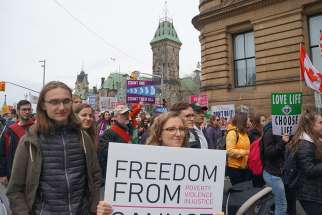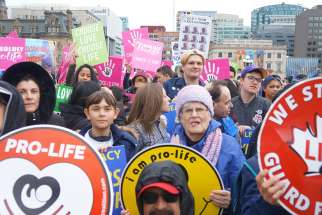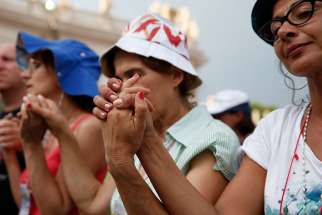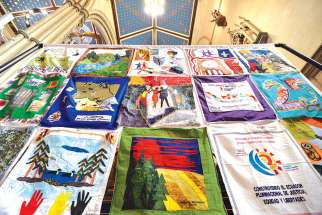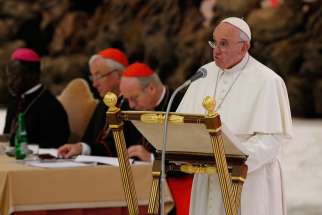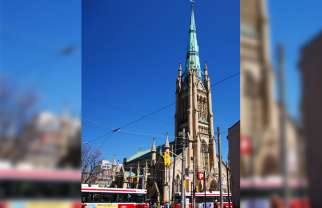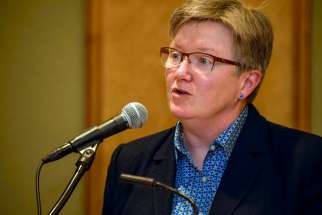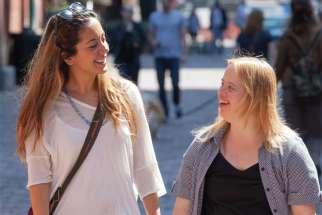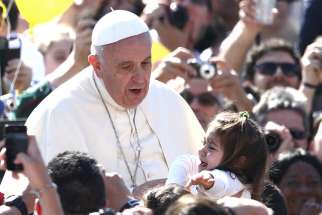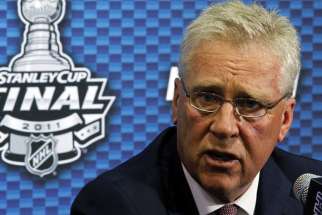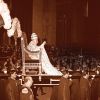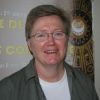OTTAWA — Despite logistical challenges and a competing March in Toronto, the 22nd National March for Life drew thousands to Parliament Hill May 9 to mark the 50th anniversary of abortion in Canada.
OTTAWA —Marches of Life in Ottawa and in a number of provincial capitals, including Toronto, marked the 50th anniversary of legalized abortion in Canada May 9.
VATICAN CITY – Pope Francis has invited thousands of Catholic charismatics and members of Pentecostal and Evangelical churches to Rome to celebrate Pentecost and mark the 50th anniversary of what became the Catholic Charismatic Renewal.
D&P’s fifty years of solidarity celebrated
Toronto Development and Peace members celebrated a half-century of solidarity at a Mass in St. Michael’s Cathedral with Cardinal Thomas Collins March 4.
To D&P, food is ‘At the Heart of the Action’
For almost 50 years solidarity with those in greatest need has been the central, driving purpose of the Canadian bishops’ Catholic development agency.
VATICAN CITY - Marking the 50th anniversary of the Synod of Bishops, Pope Francis outlined his vision for a church that is "synodal" at every level, with everyone listening to one another, learning from one another and taking responsibility for proclaiming the Gospel.
Catholics, Anglicans to bring ‘Pilgrims Together’
TORONTO - Convinced that Church unity can only be the result of devout prayer and serious thinking, Anglicans and Catholics are getting together to do both at St. James Anglican Cathedral in Toronto Nov. 9.
Ecumenism needs to get more pastoral
TORONTO - Fifty years on, it’s time for the ecumenical movement to take on a more pastoral mission and worry less about trying to untie the knots of history and theology, Saint Paul University theology professor Catherine Clifford told a small gathering of bishops, clergy and lay people in Toronto commemorating the 50th anniversary of the Second Vatican Council’s Decree on Ecumenism.
L’Arche at 50: Half a century of kindness and care
L'Arche has been with us for 50 years. A half century ago, in a very different world, Jean Vanier started something in the French countryside that has made the whole world think about what it means to be human, what we owe to our humanity and how we care for the broken and fragile among us. Fifty years of kindness and care, hope and humanity is worth celebrating.
Celebrating life at fork in the road
There’s a fork in the road on Manger Street in Bethlehem, just before you reach the separation wall and the main Israeli checkpoint. Down the road that runs parallel to the wall you find Ma’an lil-Hayat, a L’Arche project. The Arabic name means “Human Life.”
Pope’s Holy Land visit not your ordinary pilgrimage
The “principle purpose” of the May 24-26 visit of Pope Francis to the Holy Land is not a conventional pilgrimage, as conducted by John Paul II and Benedict XVI. It is to commemorate the 50th anniversary of the meeting between Pope Paul VI and the Ecumenical Patriarch Athenagoras I.
A Church reborn: The 50th Anniversary of Vatican II
On Jan. 25, 1959, a new pope shocked the world. Pope John XXIII, speaking to a small group of Roman cardinals following a liturgy to conclude the Week of Prayer for Christian Unity, announced that he had decided to convene an ecumenical council.
Pope John, elected less than three months earlier, had previously told only one person of his plan and had consulted with no one else. He had little ideaof why he wanted a council. He did however refer to “the strengthening of religious unity and the kindling of a more intense Christian fervour.”
The Church, he said, was on the threshold of a new era in history when it would be necessary “to define clearly and distinguish between what is sacredprinciple and eternal Gospel and what belongs rather to the changing times.”
With those comments, Pope John struck a few notes that would eventually help to characterize the much-maligned “spirit of Vatican II,” but not until after concerted resistance from the Vatican’s own Curia had been overcome.
Essentially, the Pope’s decision to call the council was an inspiration or an intuition that such a great gathering was needed. When the council finally opened on Oct. 11, 1962, he said the idea for the council had come “like a flash of heavenly light” . . . “a sudden emergence in our heart and on our lips of the simple words ‘ecumenical council.’ ”
Few, if any, ranking churchmen in early 1959 believed that a council was necessary. In the past, councils had been called to respond to crises in the Church, especially over doctrine. But now there was no doctrinal crisis nor was there a pastoral crisis. The Church was apparently in wonderful shape, certain of its teaching and, throughout the Western world, its worship halls were full.
Moreover, after the First Vatican Council in 1870 had declared the doctrine of the infallibility of the Pope, many believed that there would never again be a need for a worldwide council. Gotta problem? The Pope will solve it with a clear, unequivocal declaration.
But Pope John did call a council. And what a council it was! Fifty years later, its reverberations are still being felt throughout the Church. Indeed, the debate over what the council said and meant is ongoing, even increasing in fervour. The process of implementing the council is still incomplete.
Today, the 16 documents of the Second Vatican Council form a foundation for the life of the Church. But if in 1965 those documents seemed almost revolutionary, today they seem less so.
Angelo Giuseppi Roncalli became a pope like no other in the 20th century. He rose to become Pope John XXIII basically under the radar and was formed by a unique set of experiences that helped him understand that the action of the Holy Spirit is not confined to the Catholic Church.
He was not a radical or even an innovator. Judged by today’s standards, his public comments and private correspondence can only be described as quite conservative. While his papacy had a markedly different style than that of Pope Pius XII, his reserved predecessor, Pope John seems to have taken only one off-the-wall action in his life — to convoke Vatican II.
In October 1958, Pope Pius XII died after years of illness. Roncalli was quickly seen as one of the leading candidates to be his successor. Why? First, at age 76, he would be a transitional pope after Pius’ long 19-year pontificate. Second, he was not part of the Vatican power structure that had grown too strong in Pius’ declining years. Third, he was seen as a bridge-builder, someone who would be accessible to the cardinals and a pastor to the people.
Further, although he was 76, Roncalli was actually one of the younger cardinals. Pius had held only two consistories to appoint new cardinals during his long pontificate. With only 51 cardinals entering the conclave and many of them quite elderly, the pool of papal candidates was small.
Still, it took 11 ballots before he was finally elected. Why the hesitation? Some, it appears, felt Roncalli lacked the intellectual heft to lead the Church, even for a short period. Nevertheless, he was elected and chose the name John. Less than three months later, this “transitional pope,” without consulting anyone other than the Holy Spirit, started the wheels in motion for the Second Vatican Council.
Recently, a group of scholars published a book, Vatican II: Renewal Within Tradition. The book examines the 16 documents in some detail, carefully pointing out that the council did not erase what came before it. The teachings of Vatican II are totally in continuity with what the Church had taught previously. There is evolution and development of doctrine, but no radical break with the past.
This may be true, but those old enough to remember the Church before Vatican II, and who recall the earthquake that it represented in the life of the Church, cannot be satisfied with such a placid account.
Franciscan Father Don MacDonald, who teaches a course on Vatican II at Newman Theological College in Edmonton, believes Vatican II has been misunderstood. Some believe the purpose of the council was to make being a Catholic easier and to help Catholicism adapt to the modern world. That’s wrong on both accounts.
The Church has never tried to adapt itself to the world, MacDonald said, and the council made the faith more demanding, “in the best sense of the word.” The Church before Vatican II was not the good ol’ days, he said. A lot needed to change.
In the seminary, MacDonald recalls being taught that how a priest celebrates Mass was more important than what was being celebrated. The emphasis placed on how the priest held his hands during Mass “was almost like a phys-ed exercise.”
Still, there was a lot of “heroic Catholicism” and a strong emphasis on social action in the Church prior to the council, he said. “You have to have respect for that pre-Vatican II faith.”
There is more to Vatican II than what is found by studying its documents. If there was doctrinal continuity in the council’s teachings, there was also an enormous upheaval in the life of the Church. Some of that upheaval may well be due to misinterpretations and over-enthusiasms. Part of it is no doubt the result of a greater embracing of Western culture which, in the 1960s, underwent massive convulsions.
But above and beyond all that, a sea change took place in the Church that was necessary and productive.
The liturgy underwent a process of revitalization that is still continuing. Greater contact with non-Catholic Christians and people of other faiths was encouraged. A static, deadening approach to theology was jettisoned in favour of one that allowed room for inquiry and evolution.
The Church endorsed religious liberty and rejected the notion that error has no rights. The full equality of the People of God in Baptism was recognized and holiness was seen as God’s call to everyone, not just a spiritual elite. There was, in short, greater openness and less fear of “enemies.”
For many, that openness was disorienting. When the central religious rituals of one’s life are altered, it is likely to deeply unsettle one’s relationship with the Transcendent. That fact and the effects of other changes were not sufficiently appreciated in the mid- 1960s. These are likely not the only causes of a mass exodus of priests and religious from their callings and laity from regular Church attendance. But an honest evaluation of the changes should see them as contributing factors.
Still, a reform of the liturgy was necessary and perhaps overdue. As well, it must be said that one can be faithful to the letter of the Church’s teachings and still acknowledge a legitimate “spirit of Vatican II” that is in harmony with those teachings. It is impossible to tell the full story of Vatican II without acknowledging its history and without trying to come to grips with that legitimate spirit.
Communications and transportation networks were far less developed 50 years ago. As well, the Church’s theology of collegiality among bishops was practically non-existent and there were few joint episcopal efforts. When the bishops arived at Vatican II in 1962, many were meeting prelates from around the world for the first time.
Canada’s bishops and Catholic universities were among those who responded to the Vatican’s call in 1959 for input about topics to be considered at the Second Vatican Council. Canada was a far different country then and the same could be said for the Canadian Church. If parishes and dioceses today seem to be somewhat isolated cocoons, it’s nothing compared with the situation prior to Vatican II.
Given all that, it is perhaps not surprising that suggestions from Canada’s bishops lacked vision. In the mid-1990s, Michael Fahey of the University of St. Michael’s College in Toronto examined the input of the Canadian bishops prior to the council. For the most part, it reflected “notably weak” theology and the “generally poor state of collegiality in Canada,” Fahey wrote in L’Eglise canadienne et Vatican II (edited by Gilles Routhier). But what is remarkable, he noted, is the extent to which their vision was transformed by the time Vatican II ended in 1965.
What did the Pope expect out of Vatican II? Raised in the tiny village of Sotto il Monte by peasant farmers who kept cows in their house, Pope John had the audacity to convoke an ecumenical council of the entire Roman Catholic Church. Moreover, he didn’t even have a plan for this whimsical council. But he said it would provide for “the enlightenment, edification and joy of the entire Christian people” and that the faithful of other Christian churches would be invited too.
The Pope said the idea to call the council came to him “like a flash of heavenly light.” Other Church leaders felt quite in the dark.
Pope John was known for his sense of humour and his positive outlook on life. Perhaps it was these factors that led him to say, two years after his Jan. 25, 1959 announcement that the Church would hold a worldwide council, that the announcement was greeted by the cardinals present with “a devout and impressive silence.”
No applause greeted the papal announcement in the Basilica of St. Paul. Church historian Giuseppe Alberigo says the reaction of the 17 cardinals present was “characterized by bewilderment and worry.”
No one in the know could see any reason for a council. For the Rome-based cardinals, who had run their offices at the Vatican with little oversight from the ailing Pope Pius XII for several years, a general council could only mean trouble. The Vatican would be flooded with bishops from around the world, bishops unfamiliar with Roman ways, the vast majority of whom the cardinals themselves did not know.
Even Cardinal Giacomo Lecaro of Bologna, who would later become one of the progressive leaders at Vatican II, groused, “How dare he summon a council after 100 years and only three months after his election? Pope John has been rash and impulsive. His inexperience and lack of culture brought him to this pass, to this paradox.”
Cardinal Giovanni Battista Montini, later Pope Paul VI, was initially cool to the call for a council. But perhaps inspired by the excitement in his Milan archdiocese, he wrote a pastoral letter stating, “A flame of enthusiasm swept over the whole Church. He understood immediately, perhaps by inspiration, that by calling a council he would release unparalleled vital forces in the Church.”
If many cardinals were dubious about the council, the rest of the world was not. Almost spontaneously, people around the world — Catholic and non-Catholic — saw the council as a great sign of hope and renewal in the Church. The expectation created overnight was tremendous.
(Western Catholic Reporter)
OTTAWA - An Ottawa conference Sept. 27-29 marking the 50th anniversary of the Second Vatican Council will examine how to “hand on the
Gospel today” in light of Vatican II’s teachings, said Saint Paul University theology professor Catherine Clifford.
“One of goals is to promote the pastoral renewal of the Church,” said Clifford, an organizer of the Vatican II: For the Next Generation Conference. Co-sponsored by Saint Paul’s Vatican II and 21st Century Catholicism Research Centre and Novalis, the conference will begin a week before bishops from around the world gather in Rome for the Synod on the New Evangelization.
“The world we live in today is very different from the world 50 years ago,” Clifford said. “Many of the questions are not the same questions the bishops were reflecting on in 1962-65 in the Council.”
When Vatican II opened 50 years ago, it took place against the backdrop of the Cold War, less than 20 years after the end of the Second World War, said Clifford. Since then there has been a marked shift to the global integration of societies and culture, she said.
“It’s an era of an unprecedented migration of peoples,” she said. “The population of the world has more than doubled; the population of the Catholic Church has more than doubled.
“The majority of Catholics live not in Europe and North America but in the Southern hemisphere. We are a very different Church than we were 50 years ago.”
Though poverty and social injustice remain challenges, “in some ways those issues are far more complex than they were 50 years ago,” she said.
Another sign is the growing recognition of the dignity of the human person that is probably even stronger than it was 50 years ago, when the civil rights movement in the United States was gaining momentum, she said.
The conference will feature a keynote address by Cardinal Peter Turkson, president of the Pontifical Council for Justice and Peace and one of the names that frequently appears in speculation about future popes. The cardinal will speak on “Vatican II: A Council of Justice and Peace.” He will also receive an honorary doctorate at a special convocation in the university chapel on Sept. 28.
Other conference attendees include dogmatic theology professor Christoph Theobold, S.J., from the Centre Sèvres in Paris, France, and Boston College systematic theology professor Richard Gaillardetz. The conference will feature a panel of bishops and advisors who participated in the Council, including Bishop Remi De Roo and Bishop Gerard J. Deschamps, and advisors Gregory Baum and Leo Laberge, omi.
See www.ustpaul.ca or e-mail vaticancentre@ustpaul.ca.


